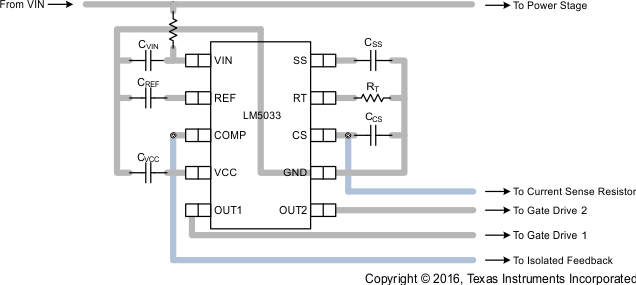SNVS181C April 2004 – August 2016 LM5033
PRODUCTION DATA.
- 1 Features
- 2 Applications
- 3 Description
- 4 Revision History
- 5 Pin Configuration and Functions
- 6 Specifications
- 7 Detailed Description
- 8 Application and Implementation
- 9 Power Supply Recommendations
- 10Layout
- 11Device and Documentation Support
- 12Mechanical, Packaging, and Orderable Information
パッケージ・オプション
メカニカル・データ(パッケージ|ピン)
サーマルパッド・メカニカル・データ
発注情報
10 Layout
10.1 Layout Guidelines
The LM5033 current sense and PWM comparators are very fast, and as such responds to short-duration noise pulses. Layout considerations are critical for the current sense filter. The components at COMP, CS, RT/SYNC, and SS pins must be placed as close as possible to the IC, thereby minimizing noise pickup in the printed-circuit tracks.
If a current sense transformer is used both leads of the transformer secondary must be routed to the sense filter components, and to the IC pins. The ground side of the transformer must be connected through a dedicated printed-circuit track to GND of the IC rather than through the ground plane.
If the current sense circuit employs a sense resistor in the drive transistor sources, a low-inductance resistor must be used. In this case all the noise-sensitive low-power grounds must be connected in common near the IC, and then a single connection made to the power ground (sense resistor ground point).
The outputs of the LM5033, or of the high-voltage gate driver (if used), must have short, direct paths to the power MOSFETs to minimize the effects of inductance in the PCB traces.
If the internal dissipation of the LM5033 and any of the power devices produces high junction temperatures during normal operation, good use of the PCB ground plane can help considerably to dissipate heat. The exposed pad on the bottom of the 10-pin WSON package can be soldered to the ground plane on the PCB, and the ground plane must extend out from beneath the IC to help dissipate the heat. The exposed pad is internally connected to the IC substrate.
Additionally, the use of wide PCB traces where possible can help conduct heat away from the IC. Judicious positioning of the PCB within the end product, along with use of any available air flow (forced or natural convection) can help reduce the junction temperatures.
10.2 Layout Example
 Figure 16. Layout Recommendation
Figure 16. Layout Recommendation